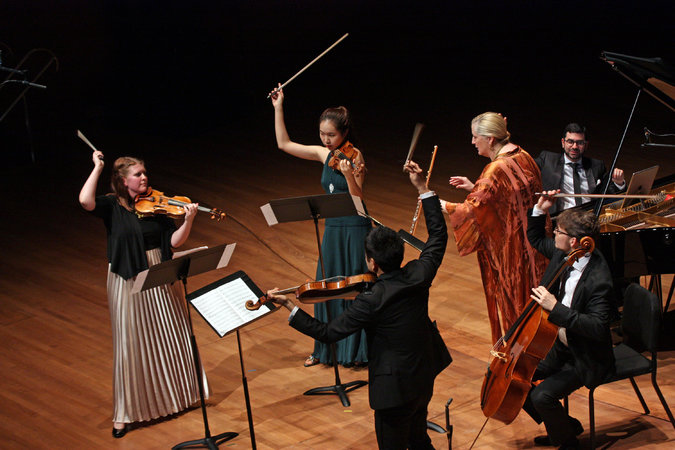By Corinna da Fonseca-Wollheim, The New York Times
October 19, 2016
» Original Link

Haydn’s “Surprise” Symphony gets its nickname from a fortissimo chord placed where it has no business being, at the end of the second go-round of a quiet little ditty that sounds like a nursery game played on tiptoes. Performed with conviction and a dose of mischief, it should make listeners jump.
On Tuesday, the Chamber Music Society of Lincoln Center opened its season at Alice Tully Hall with an arrangement of the “Surprise” that proved that sometimes size does matter. The players — the pianist Michael Brown, the violinists Erin Keefe and Danbi Um, the violist Richard O’Neill, the cellist Mihai Marica and the flutist Tara Helen O’Connor — did their utmost to exaggerate the tininess of their sound in the opening of the Andante. But on the “surprise” chord, their combined fortissimo amounted to little more than a poke. How about giving Ms. O’Connor a foot-pedal-operated bass drum to make up for the missing timpani’s firepower?
Then again, the Chamber Music Society has grown into such a successful venture because it knows how to jolt its audiences like a chiropractor: carefully, and with consent. The new season is a good example. Built around the theme of Mendelssohn — he traveled! he revived Bach! — the core series is dominated by relentlessly unthreatening standards.
More challenging fare — contemporary music or works by lesser-known composers — is largely relegated to smaller performance spaces. These often draw a capacity crowd that seems entirely distinct from that filling Alice Tully Hall. (One exception will be Sunday’s concert in Tully by the box-office-safe Emerson Quartet, which includes a new work by Mark-Anthony Turnage.)
Tuesday’s program was billed as a postcard-size sketch of the season, with each work representing a stop on Mendelssohn’s European tour. The Haydn stood for London, where it was first performed. Berlin was represented by select Mendelssohn songs, which the soprano Lisette Oropesa, accompanied by the pianist Gilbert Kalish, rendered with pellucid tone and unfussy styling, but little textual clarity.
Schubert’s more overtly operatic “Der Hirt auf dem Felsen” (“The Shepherd on the Rock,” standing in for Vienna) proved a better vehicle for Ms. Oropesa’s charm as she traded phrases with the clarinetist David Shifrin.
Two bite-size works for string quartet represented Rome and Mendelssohn’s interest in early music: a three-minute arrangement of the “Sanctus” from Palestrina’s “Missa Aeterna Christi Munera” and Mendelssohn’s short Fugue in E flat (Op. 81).
The only truly substantial offering came last, when Mr. Brown, Ms. Keefe and Mr. Marica gave a stunning performance of Ravel’s Piano Trio in A minor (representing France). Here, finally, was a wealth of delicate surprises, especially in the fascinating array of colors the players produced, from the monastic severity of the deep piano ruminations in the Passacaille to the iridescent halo created by the strings’s harmonics in the Finale.
© Michael Brown, All Rights Reserved. Site by ycArt design studio